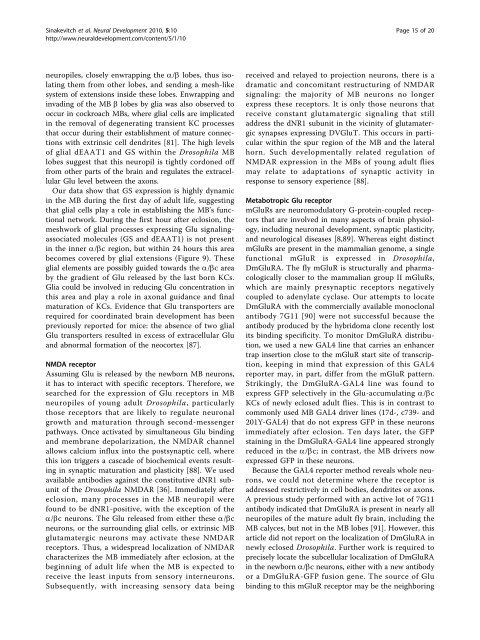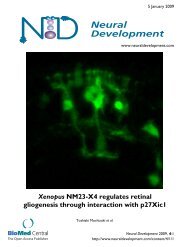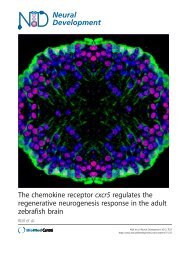Dynamics of glutamatergic signaling in the mushroom ... - HAL - ESPCI
Dynamics of glutamatergic signaling in the mushroom ... - HAL - ESPCI
Dynamics of glutamatergic signaling in the mushroom ... - HAL - ESPCI
Create successful ePaper yourself
Turn your PDF publications into a flip-book with our unique Google optimized e-Paper software.
S<strong>in</strong>akevitch et al. Neural Development 2010, 5:10<br />
http://www.neuraldevelopment.com/content/5/1/10<br />
Page 15 <strong>of</strong> 20<br />
neuropiles, closely enwrapp<strong>in</strong>g <strong>the</strong> a/b lobes, thus isolat<strong>in</strong>g<br />
<strong>the</strong>m from o<strong>the</strong>r lobes, and send<strong>in</strong>g a mesh-like<br />
system <strong>of</strong> extensions <strong>in</strong>side <strong>the</strong>se lobes. Enwrapp<strong>in</strong>g and<br />
<strong>in</strong>vad<strong>in</strong>g <strong>of</strong> <strong>the</strong> MB b lobes by glia was also observed to<br />
occur <strong>in</strong> cockroach MBs, where glial cells are implicated<br />
<strong>in</strong> <strong>the</strong> removal <strong>of</strong> degenerat<strong>in</strong>g transient KC processes<br />
that occur dur<strong>in</strong>g <strong>the</strong>ir establishment <strong>of</strong> mature connections<br />
with extr<strong>in</strong>sic cell dendrites [81]. The high levels<br />
<strong>of</strong> glial dEAAT1 and GS with<strong>in</strong> <strong>the</strong> Drosophila MB<br />
lobes suggest that this neuropil is tightly cordoned <strong>of</strong>f<br />
from o<strong>the</strong>r parts <strong>of</strong> <strong>the</strong> bra<strong>in</strong> and regulates <strong>the</strong> extracellular<br />
Glu level between <strong>the</strong> axons.<br />
Our data show that GS expression is highly dynamic<br />
<strong>in</strong> <strong>the</strong> MB dur<strong>in</strong>g <strong>the</strong> first day <strong>of</strong> adult life, suggest<strong>in</strong>g<br />
that glial cells play a role <strong>in</strong> establish<strong>in</strong>g <strong>the</strong> MB’s functional<br />
network. Dur<strong>in</strong>g <strong>the</strong> first hour after eclosion, <strong>the</strong><br />
meshwork <strong>of</strong> glial processes express<strong>in</strong>g Glu <strong>signal<strong>in</strong>g</strong>associated<br />
molecules (GS and dEAAT1) is not present<br />
<strong>in</strong> <strong>the</strong> <strong>in</strong>ner a/bc region, but with<strong>in</strong> 24 hours this area<br />
becomes covered by glial extensions (Figure 9). These<br />
glial elements are possibly guided towards <strong>the</strong> a/bc area<br />
by <strong>the</strong> gradient <strong>of</strong> Glu released by <strong>the</strong> last born KCs.<br />
Glia could be <strong>in</strong>volved <strong>in</strong> reduc<strong>in</strong>g Glu concentration <strong>in</strong><br />
this area and play a role <strong>in</strong> axonal guidance and f<strong>in</strong>al<br />
maturation <strong>of</strong> KCs. Evidence that Glu transporters are<br />
required for coord<strong>in</strong>ated bra<strong>in</strong> development has been<br />
previously reported for mice: <strong>the</strong> absence <strong>of</strong> two glial<br />
Glu transporters resulted <strong>in</strong> excess <strong>of</strong> extracellular Glu<br />
and abnormal formation <strong>of</strong> <strong>the</strong> neocortex [87].<br />
NMDA receptor<br />
Assum<strong>in</strong>g Glu is released by <strong>the</strong> newborn MB neurons,<br />
it has to <strong>in</strong>teract with specific receptors. Therefore, we<br />
searched for <strong>the</strong> expression <strong>of</strong> Glu receptors <strong>in</strong> MB<br />
neuropiles <strong>of</strong> young adult Drosophila, particularly<br />
those receptors that are likely to regulate neuronal<br />
growth and maturation through second-messenger<br />
pathways. Once activated by simultaneous Glu b<strong>in</strong>d<strong>in</strong>g<br />
and membrane depolarization, <strong>the</strong> NMDAR channel<br />
allows calcium <strong>in</strong>flux <strong>in</strong>to <strong>the</strong> postsynaptic cell, where<br />
this ion triggers a cascade <strong>of</strong> biochemical events result<strong>in</strong>g<br />
<strong>in</strong> synaptic maturation and plasticity [88]. We used<br />
available antibodies aga<strong>in</strong>st <strong>the</strong> constitutive dNR1 subunit<br />
<strong>of</strong> <strong>the</strong> Drosophila NMDAR [36]. Immediately after<br />
eclosion, many processes <strong>in</strong> <strong>the</strong> MB neuropil were<br />
found to be dNR1-positive, with <strong>the</strong> exception <strong>of</strong> <strong>the</strong><br />
a/bc neurons. The Glu released from ei<strong>the</strong>r <strong>the</strong>se a/bc<br />
neurons, or <strong>the</strong> surround<strong>in</strong>g glial cells, or extr<strong>in</strong>sic MB<br />
<strong>glutamatergic</strong> neurons may activate <strong>the</strong>se NMDAR<br />
receptors. Thus, a widespread localization <strong>of</strong> NMDAR<br />
characterizes <strong>the</strong> MB immediately after eclosion, at <strong>the</strong><br />
beg<strong>in</strong>n<strong>in</strong>g <strong>of</strong> adult life when <strong>the</strong> MB is expected to<br />
receive <strong>the</strong> least <strong>in</strong>puts from sensory <strong>in</strong>terneurons.<br />
Subsequently, with <strong>in</strong>creas<strong>in</strong>g sensory data be<strong>in</strong>g<br />
received and relayed to projection neurons, <strong>the</strong>re is a<br />
dramatic and concomitant restructur<strong>in</strong>g <strong>of</strong> NMDAR<br />
<strong>signal<strong>in</strong>g</strong>: <strong>the</strong> majority <strong>of</strong> MB neurons no longer<br />
express <strong>the</strong>se receptors. It is only those neurons that<br />
receive constant <strong>glutamatergic</strong> <strong>signal<strong>in</strong>g</strong> that still<br />
address <strong>the</strong> dNR1 subunit <strong>in</strong> <strong>the</strong> vic<strong>in</strong>ity <strong>of</strong> <strong>glutamatergic</strong><br />
synapses express<strong>in</strong>g DVGluT. This occurs <strong>in</strong> particular<br />
with<strong>in</strong> <strong>the</strong> spur region <strong>of</strong> <strong>the</strong> MB and <strong>the</strong> lateral<br />
horn. Such developmentally related regulation <strong>of</strong><br />
NMDAR expression <strong>in</strong> <strong>the</strong> MBs <strong>of</strong> young adult flies<br />
may relate to adaptations <strong>of</strong> synaptic activity <strong>in</strong><br />
response to sensory experience [88].<br />
Metabotropic Glu receptor<br />
mGluRs are neuromodulatory G-prote<strong>in</strong>-coupled receptors<br />
that are <strong>in</strong>volved <strong>in</strong> many aspects <strong>of</strong> bra<strong>in</strong> physiology,<br />
<strong>in</strong>clud<strong>in</strong>g neuronal development, synaptic plasticity,<br />
and neurological diseases [8,89]. Whereas eight dist<strong>in</strong>ct<br />
mGluRs are present <strong>in</strong> <strong>the</strong> mammalian genome, a s<strong>in</strong>gle<br />
functional mGluR is expressed <strong>in</strong> Drosophila,<br />
DmGluRA. The fly mGluR is structurally and pharmacologically<br />
closer to <strong>the</strong> mammalian group II mGluRs,<br />
which are ma<strong>in</strong>ly presynaptic receptors negatively<br />
coupled to adenylate cyclase. Our attempts to locate<br />
DmGluRA with <strong>the</strong> commercially available monoclonal<br />
antibody 7G11 [90] were not successful because <strong>the</strong><br />
antibody produced by <strong>the</strong> hybridoma clone recently lost<br />
its b<strong>in</strong>d<strong>in</strong>g specificity. To monitor DmGluRA distribution,<br />
we used a new GAL4 l<strong>in</strong>e that carries an enhancer<br />
trap <strong>in</strong>sertion close to <strong>the</strong> mGluR start site <strong>of</strong> transcription,<br />
keep<strong>in</strong>g <strong>in</strong> m<strong>in</strong>d that expression <strong>of</strong> this GAL4<br />
reporter may, <strong>in</strong> part, differ from <strong>the</strong> mGluR pattern.<br />
Strik<strong>in</strong>gly, <strong>the</strong> DmGluRA-GAL4 l<strong>in</strong>e was found to<br />
express GFP selectively <strong>in</strong> <strong>the</strong> Glu-accumulat<strong>in</strong>g a/bc<br />
KCs <strong>of</strong> newly eclosed adult flies. This is <strong>in</strong> contrast to<br />
commonly used MB GAL4 driver l<strong>in</strong>es (17d-, c739- and<br />
201Y-GAL4) that do not express GFP <strong>in</strong> <strong>the</strong>se neurons<br />
immediately after eclosion. Ten days later, <strong>the</strong> GFP<br />
sta<strong>in</strong><strong>in</strong>g <strong>in</strong> <strong>the</strong> DmGluRA-GAL4 l<strong>in</strong>e appeared strongly<br />
reduced <strong>in</strong> <strong>the</strong> a/bc; <strong>in</strong> contrast, <strong>the</strong> MB drivers now<br />
expressed GFP <strong>in</strong> <strong>the</strong>se neurons.<br />
Because <strong>the</strong> GAL4 reporter method reveals whole neurons,<br />
we could not determ<strong>in</strong>e where <strong>the</strong> receptor is<br />
addressed restrictively <strong>in</strong> cell bodies, dendrites or axons.<br />
A previous study performed with an active lot <strong>of</strong> 7G11<br />
antibody <strong>in</strong>dicated that DmGluRA is present <strong>in</strong> nearly all<br />
neuropiles <strong>of</strong> <strong>the</strong> mature adult fly bra<strong>in</strong>, <strong>in</strong>clud<strong>in</strong>g <strong>the</strong><br />
MB calyces, but not <strong>in</strong> <strong>the</strong> MB lobes [91]. However, this<br />
article did not report on <strong>the</strong> localization <strong>of</strong> DmGluRA <strong>in</strong><br />
newly eclosed Drosophila. Fur<strong>the</strong>r work is required to<br />
precisely locate <strong>the</strong> subcellular localization <strong>of</strong> DmGluRA<br />
<strong>in</strong> <strong>the</strong> newborn a/bc neurons, ei<strong>the</strong>r with a new antibody<br />
or a DmGluRA-GFP fusion gene. The source <strong>of</strong> Glu<br />
b<strong>in</strong>d<strong>in</strong>g to this mGluR receptor may be <strong>the</strong> neighbor<strong>in</strong>g




